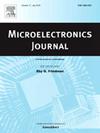An 8-bit 1.16 mw 500 ms/s SAR ADC with bidirectional-bit-distribution-based offset calibration and partially activated accelerating current source
IF 1.9
3区 工程技术
Q3 ENGINEERING, ELECTRICAL & ELECTRONIC
引用次数: 0
Abstract
This paper presents an 8-bit 500MS/s single-channel Successive Approximation Register (SAR) Analog-to-Digital Converter (ADC). It features: 1) a fast-converging bidirectional-bit-distribution-based (BBDB) ping-pong comparator calibration, which bidirectionally adjusts the offset of the two comparators to their mean values, and reduces the offset standard deviation to 0.707 times initial offset value; and 2) the use of partially activated accelerating current source (ACS), depending on the operating state of the SAR ADC. When ACS is enabled, it reduces the single-bit decision time of the comparator by at least 14%. The prototype ADC, implemented in a 40 nm Low-Leakage CMOS process, achieves post simulated SNDR and SFDR of 47.4 dB and 65.7 dB, respectively, at Nyquist frequency input. Operating at a 1.1 V single supply, the ADC consumes 1.16 mW, leading to the Walden figure of merit (FoMw) of 12.2 fJ/conv-step.
一个8位的1.16 mw 500 ms/s SAR ADC,基于双向位分布的偏移校准和部分激活的加速电流源
本文介绍了一种8位500MS/s单通道逐次逼近寄存器(SAR)模数转换器(ADC)。其特点是:1)基于BBDB(双向位分布)的快速收敛乒乓比较器校准,将两个比较器的偏移量双向调整到其平均值,并将偏移标准差降低到初始偏移值的0.707倍;2)使用部分激活的加速电流源(ACS),这取决于SAR ADC的工作状态。当启用ACS时,它将比较器的单比特决策时间减少至少14%。该原型ADC采用40 nm低漏CMOS工艺实现,在Nyquist频率输入下,SNDR和SFDR分别达到47.4 dB和65.7 dB。在1.1 V单电源下工作,ADC消耗1.16 mW,导致瓦尔登品质系数(FoMw)为12.2 fJ/反相步长。
本文章由计算机程序翻译,如有差异,请以英文原文为准。
求助全文
约1分钟内获得全文
求助全文
来源期刊

Microelectronics Journal
工程技术-工程:电子与电气
CiteScore
4.00
自引率
27.30%
发文量
222
审稿时长
43 days
期刊介绍:
Published since 1969, the Microelectronics Journal is an international forum for the dissemination of research and applications of microelectronic systems, circuits, and emerging technologies. Papers published in the Microelectronics Journal have undergone peer review to ensure originality, relevance, and timeliness. The journal thus provides a worldwide, regular, and comprehensive update on microelectronic circuits and systems.
The Microelectronics Journal invites papers describing significant research and applications in all of the areas listed below. Comprehensive review/survey papers covering recent developments will also be considered. The Microelectronics Journal covers circuits and systems. This topic includes but is not limited to: Analog, digital, mixed, and RF circuits and related design methodologies; Logic, architectural, and system level synthesis; Testing, design for testability, built-in self-test; Area, power, and thermal analysis and design; Mixed-domain simulation and design; Embedded systems; Non-von Neumann computing and related technologies and circuits; Design and test of high complexity systems integration; SoC, NoC, SIP, and NIP design and test; 3-D integration design and analysis; Emerging device technologies and circuits, such as FinFETs, SETs, spintronics, SFQ, MTJ, etc.
Application aspects such as signal and image processing including circuits for cryptography, sensors, and actuators including sensor networks, reliability and quality issues, and economic models are also welcome.
 求助内容:
求助内容: 应助结果提醒方式:
应助结果提醒方式:


